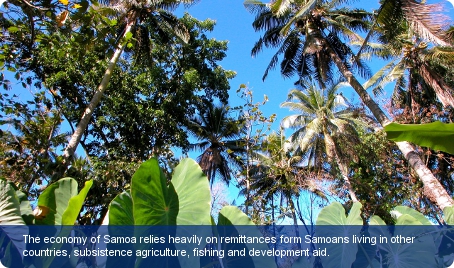Find a business in Samoa

Samoa, an archipelago of nine islands, in the south-west Pacific has a small but buoyant economy that relies on remittances from Samoans living overseas as well as subsistence agriculture. Coconut is one of the primary cash crops that are grown for export but this leaves the economy vulnerable to natural hazards and fluctuations in world prices for commodities. Samoa has a GNI per capita of US$3,260 (2012) and has seen GDP growth of 0.7% per annum (2008–12). The economy has diversified and there has been strong growth in manufacturing, the fisheries sector, tourism and the offshore financial sector.
The agriculture sector contributes 10% of GDP (2010) with over 65% of the labour force working in this sector and providing 90% of all exports. Commercial fishing, fisheries, and fish farming accounts for roughly over 40% of the value of exports but the country is vulnerable to climatic fluctuations such as El Niño which badly affected the fishing sector in 2002/03. Bananas and coconuts, coconut cream, coconut oil and copra are Samoa’s main agricultural exports. The majority of farmers in Samoa fall into subsistence category with surplus sold for cash. Large-scale commercial agriculture is hampered by Samoa’s annual cyclone season, the costs of export, the lack of viable land for commercial farming development and the lack of quality soils.
Despite Samoa having amongst the smallest fishing grounds in the region (its exclusive economic zone – EEZ – is only 124,000 sq km), it has not stopped its fishing industry from developing into an important foreign exchange earner with the industry contributing around 40% of non-tourism export earnings to the local economy (2010). One company, Apia Export Fish Packers handles 80% of Samoa’s fish exports, consisting mainly of frozen albacore tuna.
Manufacturing contributes 13.6% of Samoa’s GDP (2008). A Japanese-owned automotive wiring harness company, Yazaki EDS, is the largest manufacturer, employing over 2,000 people, and is the country’s second largest employer after the government of Samoa.
Construction contributes 13% to the GDP of Samoa (2008). The construction industry underwent a mini-boom due to the rebuilding work in the aftermath of the devastating 2009 tsunami.
Tourism is an expanding sector accounting for 25% of GDP; 122,000 tourists visited the islands in 2007. Tourism is the largest single activity in Samoa, with over 100,000 visitors annually (122,000 tourist arrivals in 2007) which is more than half the population of the country. In 2009 Samoa’s tourism industry encountered major obstacles, namely the global financial crisis and the devastation of the tsunami. The tsunami ravaged a quarter of Upolu Island’s south and south-eastern coast. The tourism industry started rebuilding a week after the devastation, making use of subsidies and concessional loan assistance from the Samoan, New Zealand and Australian governments.
The government has restructured the economy and encouraged diversification where it can. The Samoan government has called for deregulation of the financial sector, encouragement of investment and continued fiscal discipline.
There are 2,337 km of roads, many being rural-access roads, 14% of them are paved. Apia, the capital, on Upolu is the international port.
Samoa is ranked 60th overall for ease of doing business, according to the World Bank’s Doing Business 2012 report. But it is ranked 22nd in the world for starting a business. These rankings measure the conduciveness of a regulatory regime in starting and operating a business.
The official languages are Samoan and English, with 98.9% of the population being literate in 2012, which is one of the highest rates in the South Pacific.



